Secondary-Frequency and Voltage-Regulation Control of Multi-Parallel Inverter Microgrid System
Abstract
1. Introduction
2. Analysis of Key Issues in Secondary-Frequency and Voltage Regulation of Microgrid System
2.1. Droop-Based Microgrid Secondary-Frequency and Voltage Regulation
2.2. Power-Balance Problem from Inverter Grid Impedance Mismatch
2.3. Secondary Regulation Problem under Disturbances, Harmonics, and Unbalance
3. Key Technologies for Secondary-Frequency and Voltage Regulation of Multi-Parallel Inverter Microgrid Systems and Their New Advances
3.1. Virtual Impedance Technique
3.2. Consensus Algorithm and Event-Triggered Mechanism
3.2.1. Event-Trigger Function
3.2.2. Zeno Phenomenon
3.2.3. Chattering
3.2.4. Consensus Signal Selection
3.3. Active Disturbance Rejection Control and Robust Control Method
3.3.1. Active Disturbance Rejection Control
3.3.2. Robust Control
4. Application Case and Future Trends
4.1. Application Case
4.2. Future Trends
5. Conclusions
Author Contributions
Funding
Conflicts of Interest
Appendix A. A Brief Proof of the Stability of the Consensus Algorithm
References
- Badal, F.R.; Das, P.; Sarker, S.K.; Das, S.K. A survey on control issues in renewable energy integration and microgrid. Prot. Control Mod. Power Syst. 2019, 4, 8. [Google Scholar] [CrossRef]
- Solanki, B.V.; Canizares, C.A.; Bhattacharya, K. Practical Energy Management Systems for Isolated Microgrids. IEEE Trans. Smart Grid 2018, 10, 4762–4775. [Google Scholar] [CrossRef]
- Palizban, O.; Kauhaniemi, K. Hierarchical control structure in microgrids with distributed generation: Island and grid-connected mode. Renew. Sustain. Energy Rev. 2015, 44, 797–813. [Google Scholar] [CrossRef]
- Wang, Y.; Nguyen, T.-L.; Xu, Y.; Tran, Q.-T.; Caire, R. Peer-to-Peer Control for Networked Microgrids: Multi-Layer and Multi-Agent Architecture Design. IEEE Trans. Smart Grid 2020, 11, 4688–4699. [Google Scholar] [CrossRef]
- Song, Y.; Hill, D.J.; Liu, T. Impact of DG Connection Topology on the Stability of Inverter-Based Microgrids. IEEE Trans. Power Syst. 2019, 34, 3970–3972. [Google Scholar] [CrossRef]
- Guo, X.; Chen, W. Control of multiple power inverters for more electronics power systems: A review. CES Trans. Electr. Mach. Syst. 2018, 2, 255–263. [Google Scholar] [CrossRef]
- Lasseter, R.H.; Chen, Z.; Pattabiraman, D. Grid-Forming Inverters: A Critical Asset for the Power Grid. IEEE J. Emerg. Sel. Top. Power Electron. 2019, 8, 925–935. [Google Scholar] [CrossRef]
- Chen, B.; Wang, J.; Lu, X.; Chen, C.; Zhao, S. Networked Microgrids for Grid Resilience, Robustness, and Efficiency: A Review. IEEE Trans. Smart Grid 2020, 12, 18–32. [Google Scholar] [CrossRef]
- Neves, R.V.A.; Machado, R.Q.; Oliveira, V.A.; Wang, X.; Blaabjerg, F. Multitask Fuzzy Secondary Controller for AC Microgrid Operating in Stand-Alone and Grid-Tied Mode. IEEE Trans. Smart Grid 2018, 10, 5640–5649. [Google Scholar] [CrossRef]
- Cao, W.; Ma, Y.; Yang, L.; Wang, F.; Tolbert, L.M. D–Q Impedance Based Stability Analysis and Parameter Design of Three-Phase Inverter-Based AC Power Systems. IEEE Trans. Ind. Electron. 2017, 64, 6017–6028. [Google Scholar] [CrossRef]
- Rocabert, J.; Luna, A.; Blaabjerg, F.; Rodríguez, P. Control of Power Converters in AC Microgrids. IEEE Trans. Power Electron. 2012, 27, 4734–4749. [Google Scholar] [CrossRef]
- Chen, J.; Milano, F.; Donnell, T.O. Assessment of Grid-Feeding Converter Voltage Stability. IEEE Trans. Power Syst. 2019, 34, 3980–3982. [Google Scholar] [CrossRef]
- Dissanayake, A.M.; Ekneligoda, N.C. Decentralized Optimal Stabilization of Active Loads in Islanded Microgrids. IEEE Trans. Smart Grid 2020, 12, 932–942. [Google Scholar] [CrossRef]
- Alghamdi, B.; Canizares, C.A. Frequency Regulation in Isolated Microgrids Through Optimal Droop Gain and Voltage Control. IEEE Trans. Smart Grid 2020, 12, 988–998. [Google Scholar] [CrossRef]
- Zhao-Xia, X.; Mingke, Z.; Yu, H.; Guerrero, J.M.; Vasquez, J.C. Coordinated Primary and Secondary Frequency Support Between Microgrid and Weak Grid. IEEE Trans. Sustain. Energy 2018, 10, 1718–1730. [Google Scholar] [CrossRef]
- Tayab, U.B.; Bin Roslan, M.A.; Hwai, L.J.; Kashif, M. A review of droop control techniques for microgrid. Renew. Sustain. Energy Rev. 2017, 76, 717–727. [Google Scholar] [CrossRef]
- Vijay, A.S.; Dheer, D.K.; Tiwari, A.; Doolla, S. Performance Evaluation of Homogeneous and Heterogeneous Droop-Based Systems in Microgrid—Stability and Transient Response Perspective. IEEE Trans. Energy Convers. 2018, 34, 36–46. [Google Scholar] [CrossRef]
- Du, W.; Chen, Z.; Schneider, K.P.; Lasseter, R.H.; Nandanoori, S.P.; Tuffner, F.K.; Kundu, S. A Comparative Study of Two Widely Used Grid-Forming Droop Controls on Microgrid Small-Signal Stability. IEEE J. Emerg. Sel. Top. Power Electron. 2019, 8, 963–975. [Google Scholar] [CrossRef]
- Andishgar, M.H.; Gholipour, E.; Hooshmand, R.A. An overview of control approaches of inverter-based microgrids in is-landing mode of operation. Renew. Sustain. Energy Rev. 2017, 80, 1043–1060. [Google Scholar] [CrossRef]
- Wang, S.; Liu, Z.; Liu, J.; Boroyevich, D.; Burgos, R. Small-Signal Modeling and Stability Prediction of Parallel Droop-Controlled Inverters Based on Terminal Characteristics of Individual Inverters. IEEE Trans. Power Electron. 2019, 35, 1045–1063. [Google Scholar] [CrossRef]
- Hu, J.; Shan, Y.; Guerrero, J.M.; Ioinovici, A.; Chan, K.W.; Rodriguez, J. Model predictive control of microgrids—An overview. Renew. Sustain. Energy Rev. 2020, 136, 110422. [Google Scholar] [CrossRef]
- Babayomi, O.; Li, Z.; Zhang, Z. Distributed Secondary Frequency and Voltage Control of Parallel-Connected VSCs in Microgrids: A Predictive VSG-Based Solution. CPSS Trans. Power Electron. Appl. 2020, 5, 342–351. [Google Scholar] [CrossRef]
- Du, W.; Lasseter, R.; Khalsa, A. Survivability of Autonomous Microgrid during Overload Events. In Proceedings of the 2020 IEEE Power & Energy Society General Meeting (PESGM), Montreal, QC, Canada, 2–6 August 2020; p. 1. [Google Scholar] [CrossRef]
- Wang, X.; Blaabjerg, F. Harmonic stability in power electronic-based power systems: Concept, modeling, and analysis. IEEE Trans. Smart Grid 2019, 10, 2858–2870. [Google Scholar] [CrossRef]
- Mahmood, H.; Jiang, J. Decentralized Power Management of Multiple PV, Battery, and Droop Units in an Islanded Microgrid. IEEE Trans. Smart Grid 2019, 2, 1898–1906. [Google Scholar] [CrossRef]
- Lu, D.; Wang, X.; Blaabjerg, F. Impedance-based analysis of dc link voltage dynamics in voltage-source converters. IEEE Trans. Power Electron. 2019, 34, 3973–3985. [Google Scholar] [CrossRef]
- Duan, J.; Wang, C.; Xu, H.; Liu, W.; Xue, Y.; Peng, J.-C.; Jiang, H. Distributed Control of Inverter-Interfaced Microgrids Based on Consensus Algorithm with Improved Transient Performance. IEEE Trans. Smart Grid. 2017, 10, 1303–1312. [Google Scholar] [CrossRef]
- Golsorkhi, M.S.; Lu, D.D.-C.; Guerrero, J. A GPS-Based Decentralized Control Method for Islanded Microgrids. IEEE Trans. Power Electron. 2016, 32, 1615–1625. [Google Scholar] [CrossRef]
- Watson, J.; Lestas, I. Frequency and Voltage Regulation in Hybrid AC/DC Networks. IEEE Trans. Control. Syst. Technol. 2020, 29, 1839–1849. [Google Scholar] [CrossRef]
- Simpson-Porco, J.; Shafiee, Q.; Dorfler, F.; Vasquez, J.; Guerrero, J.M.; Bullo, F. Secondary Frequency and Voltage Control of Islanded Microgrids via Distributed Averaging. IEEE Trans. Ind. Electron. 2015, 62, 7025–7038. [Google Scholar] [CrossRef]
- Hu, J.; Lanzon, A. Distributed Finite-Time Consensus Control for Heterogeneous Battery Energy Storage Systems in Droop-Controlled Microgrids. IEEE Trans. Smart Grid 2019, 5, 4751–4761. [Google Scholar] [CrossRef]
- Delghavi, M.B.; Yazdani, A. Sliding-Mode Control of AC Voltages and Currents of Dispatchable Distributed Energy Resources in Master-Slave-Organized Inverter-Based Microgrids. IEEE Trans. Smart Grid 2017, 10, 980–991. [Google Scholar] [CrossRef]
- Mortezaei, A.; Simoes, M.; Savaghebi, M.; Guerrero, J.; Al-Durra, A. Cooperative control of multi-master-slave islanded microgrid with power quality enhancement based on conservative power theory. IEEE Trans. Smart Grid 2018, 4, 2964–2975. [Google Scholar] [CrossRef]
- Lasheen, A.; Ammar, M.E.; Zeineldin, H.H.; Al-Durra, A.; Shaaban, M.F.; El-Saadany, E. Assessing the Impact of Reactive Power Droop on Inverter Based Microgrid Stability. IEEE Trans. Energy Convers. 2021, 36, 2380–2392. [Google Scholar] [CrossRef]
- Lou, G.; Gu, W.; Xu, Y.; Cheng, M.; Liu, W. Distributed MPC Based Secondary Voltage Control Scheme for Autonomous Droop Controlled Microgrids. IEEE Trans. Sustain. Energy 2017, 8, 792–804. [Google Scholar] [CrossRef]
- Dong, J.; Gong, C.; Chen, H.; Wang, Z. Secondary frequency regulation and stabilization method of islanded droop inverters based on integral leading compensator. Energy Rep. 2022, 8, 1718–1730. [Google Scholar] [CrossRef]
- Olfati-Saber, R.; Fax, J.A.; Murray, R.M. Consensus and Cooperation in Networked Multi-Agent Systems. Proc. IEEE 2007, 95, 215–233. [Google Scholar] [CrossRef]
- Chen, G.; Guo, Z. Distributed Secondary and Optimal Active Power Sharing Control for Islanded Microgrids with Commu-nication Delays. IEEE Trans. Smart Grid 2019, 2, 2002–2014. [Google Scholar] [CrossRef]
- Yan, Y.; Shi, D.; Bian, D.; Huang, B.; Yi, Z.; Wang, Z. Small-Signal Stability Analysis and Performance Evaluation of Microgrids Under Distributed Control. IEEE Trans. Smart Grid 2018, 10, 4848–4858. [Google Scholar] [CrossRef]
- Wang, R.; Li, W.; Sun, Q.; Li, Y.; Gui, Y.; Wang, P. Event-triggered improved consensus algorithm distributed secondary frequency regulation of multi-inverter microgrid systems with islanded operation. In Proceedings of the CSEE, Lisbon, Portugal, 10–12 April 2022. [Google Scholar]
- Xia, Y.; Xu, Y.; Wang, Y.; Mondal, S.; Dasgupta, S.; Gupta, A.K.; Gupta, G.M. A Safe Policy Learning-Based Method for Decentralized and Economic Frequency Control in Isolated Networked-Microgrid Systems. IEEE Trans. Sustain. Energy 2022, 13, 1982–1993. [Google Scholar] [CrossRef]
- Feng, K.; Liu, C. Distributed Hierarchical Control for Fast Frequency Restoration in VSG-Controlled Islanded Microgrids. IEEE Open J. Ind. Electron. Soc. 2022, 3, 496–506. [Google Scholar] [CrossRef]
- Khayat, Y.; Shafiee, Q.; Heydari, R.; Naderi, M.; Dragicevic, T.; Simpson-Porco, J.W.; Dorfler, F.; Fathi, M.; Blaabjerg, F.; Guerrero, J.M.; et al. On the Secondary Control Architectures of AC Microgrids: An Overview. IEEE Trans. Power Electron. 2020, 35, 6482–6500. [Google Scholar] [CrossRef]
- Rashidi, R.; Hatami, A.; Abedini, M. Multi-microgrid energy management through tertiary-level control: Structure and case study. Sustain. Energy Technol. Assess. 2021, 47, 101395. [Google Scholar] [CrossRef]
- Ramirez, D.A.; Garces, A.; Mora-Florez, J.J. A Convex Approximation for the Tertiary Control of Unbalanced Microgrids. Electr. Power Syst. Res. 2021, 199, 107423. [Google Scholar] [CrossRef]
- Mohammed, A.; Refaat, S.S.; Bayhan, S.; Abu-Rub, H. AC Microgrid Control and Management Strategies: Evaluation and Review. IEEE Power Electron. Mag. 2019, 6, 18–31. [Google Scholar] [CrossRef]
- Muhtadi, A.; Pandit, D.; Nguyen, N.; Mitra, J. Distributed Energy Resources Based Microgrid: Review of Architecture, Control, and Reliability. IEEE Trans. Ind. Appl. 2021, 57, 2223–2235. [Google Scholar] [CrossRef]
- Sun, H.; Guo, Q.; Qi, J.; Ajjarapu, V.; Bravo, R.; Chow, J.; Li, Z.; Moghe, R.; Nasr-Azadani, E.; Tamrakar, U.; et al. Review of Challenges and Research Opportunities for Voltage Control in Smart Grids. IEEE Trans. Power Syst. 2019, 34, 2790–2801. [Google Scholar] [CrossRef]
- Bialas, H.; Pawelek, R.; Wasiak, I. A Simulation Model for Providing Analysis of Wind Farms Frequency and Voltage Regulation Services in an Electrical Power System. Energies 2021, 14, 2250. [Google Scholar] [CrossRef]
- Razi, R.; Iman-Eini, H.; Hamzeh, M. An Impedance-Power Droop Method for Accurate Power Sharing in Islanded Resistive Microgrids. IEEE J. Emerg. Sel. Top. Power Electron. 2019, 8, 3763–3771. [Google Scholar] [CrossRef]
- Dheer, D.K.; Gupta, Y.; Doolla, S. A Self-Adjusting Droop Control Strategy to Improve Reactive Power Sharing in Islanded Microgrid. IEEE Trans. Sustain. Energy 2019, 11, 1624–1635. [Google Scholar] [CrossRef]
- Cao, W.; Ma, Y.; Wang, F.; Tolbert, L.M.; Xue, Y. Low-Frequency Stability Analysis of Inverter-Based Islanded Multiple-Bus AC Microgrids Based on Terminal Characteristics. IEEE Trans. Smart Grid 2020, 11, 3662–3676. [Google Scholar] [CrossRef]
- Mobashsher, M.M.; Keypour, R.; Savaghebi, M. Distributed optimal voltage control in islanded microgrids. Int. Transac-Tions Electr. Energy Syst. 2021, 31, 13045. [Google Scholar] [CrossRef]
- Sun, L.; Sun, K.; Hou, Y.; Hu, J. Optimized Autonomous Operation Control to Maintain the Frequency, Voltage and Accurate Power Sharing for DGs in Islanded Systems. IEEE Trans. Smart Grid 2020, 5, 3885–3895. [Google Scholar] [CrossRef]
- Ge, P.; Zhu, Y.; Green, T.C.; Teng, F. Resilient Secondary Voltage Control of Islanded Microgrids: An ESKBF-Based Distributed Fast Terminal Sliding Mode Control Approach. IEEE Trans. Power Syst. 2020, 36, 1059–1070. [Google Scholar] [CrossRef]
- Li, X.; Zhang, H.; Shadmand, M.B.; Balog, R.S. Model Predictive Control of a Voltage-Source Inverter with Seamless Transition Between Islanded and Grid-Connected Operations. IEEE Trans. Ind. Electron. 2017, 64, 7906–7918. [Google Scholar] [CrossRef]
- Ramezani, M.; Li, S.; Musavi, F.; Golestan, S. Seamless Transition of Synchronous Inverters Using Synchronizing Virtual Torque and Flux Linkage. IEEE Trans. Ind. Electron. 2019, 67, 319–328. [Google Scholar] [CrossRef]
- Lou, G.; Gu, W.; Wang, J.; Gu, B. A Unified Control Scheme Based on a Disturbance Observer for Seamless Transition Operation of Inverter-Interfaced Distributed Generation. IEEE Trans. Smart Grid 2017, 9, 5444–5454. [Google Scholar] [CrossRef]
- Ganjian-Aboukheili, M.; Shahabi, M.; Shafiee, Q.; Guerrero, J.M. Seamless Transition of Microgrids Operation From Grid-Connected to Islanded Mode. IEEE Trans. Smart Grid 2019, 11, 2106–2114. [Google Scholar] [CrossRef]
- Raeispour, M.; Atrianfar, H.; Baghaee, H.R.; Gharehpetian, G.B. Resilient H∞ Consensus-Based Control of Autonomous AC Microgrids with Uncertain Time-Delayed Communications. IEEE Trans. Smart Grid 2020, 5, 3871–3884. [Google Scholar] [CrossRef]
- Zhou, J.; Shi, M.; Chen, Y.; Chen, X.; Wen, J.; He, H. A Novel Secondary Optimal Control for Multiple Battery Energy Storages in a DC Microgrid. IEEE Trans. Smart Grid 2020, 11, 3716–3725. [Google Scholar] [CrossRef]
- Lou, G.; Gu, W.; Lu, X.; Xu, Y.; Hong, H. Distributed Secondary Voltage Control in Islanded Microgrids with Consideration of Communi-cation Network and Time Delays. IEEE Trans. Smart Grid 2020, 11, 3702–3715. [Google Scholar] [CrossRef]
- Yan, H.; Zhou, X.; Zhang, H.; Yang, F.; Wu, Z.-G. A Novel Sliding Mode Estimation for Microgrid Control with Communication Time Delays. IEEE Trans. Smart Grid 2017, 10, 1509–1520. [Google Scholar] [CrossRef]
- Rosero, C.X.; Velasco, M.; Marti, P.; Camacho, A.; Miret, J.; Castilla, M. Analysis of Consensus-Based Islanded Microgrids Subject to Unexpected Electrical and Communication Partitions. IEEE Trans. Smart Grid 2018, 10, 5125–5135. [Google Scholar] [CrossRef]
- Ali, R.; O’Donnell, T. Analysis and Mitigation of Harmonic Resonances in Multi–Parallel Grid–Connected Inverters: A Review. Energies 2022, 15, 5438. [Google Scholar] [CrossRef]
- Hart, P.J.; Goldman, J.; Lasseter, R.H.; Jahns, T.M. Impact of Harmonics and Unbalance on the Dynamics of Grid-Forming, Fre-quency-Droop-Controlled Inverters. IEEE J. Emerg. Sel. Top. Power Electron. 2020, 2, 976–990. [Google Scholar] [CrossRef]
- Acharya, S.; El-Moursi, M.S.; Al-Hinai, A.; Al-Sumaiti, A.S.; Zeineldin, H.H. A Control Strategy for Voltage Unbalance Mitigation in an Islanded Microgrid Considering Demand Side Management Capability. IEEE Trans. Smart Grid 2018, 10, 2558–2568. [Google Scholar] [CrossRef]
- Pham, M.-D.; Lee, H.-H. Effective Coordinated Virtual Impedance Control for Accurate Power Sharing in Islanded Mi-crogrid. IEEE Trans. Ind. Electron. 2021, 68, 2279–2288. [Google Scholar] [CrossRef]
- Buraimoh, E.; Aluko, A.O.; Oni, O.E.; Davidson, I.E. Decentralized Virtual Impedance- Conventional Droop Control for Power Sharing for Inverter-Based Distributed Energy Resources of a Microgrid. Energies 2022, 15, 4439. [Google Scholar] [CrossRef]
- Zhang, M.; Song, B.; Wang, J. Circulating Current Control Strategy Based on Equivalent Feeder for Parallel Inverters in Islanded Microgrid. IEEE Trans. Power Syst. 2018, 34, 595–605. [Google Scholar] [CrossRef]
- Zhang, X.; Zhong, Q.-C.; Kadirkamanathan, V.; He, J.; Huang, J. Source-Side Series-Virtual-Impedance Control to Improve the Cascaded System Stability and the Dynamic Performance of Its Source Converter. IEEE Trans. Power Electron. 2018, 34, 5854–5866. [Google Scholar] [CrossRef]
- Liang, X.; Andalib-Bin-Karim, C.; Li, W.; Mitolo, M.; Shabbir, M.N.S.K. Adaptive Virtual Impedance-Based Reactive Power Sharing in Virtual Syn-chronous Generator Controlled Microgrids. IEEE Trans. Ind. Appl. 2021, 57, 46–60. [Google Scholar] [CrossRef]
- Rodríguez-Cabero, A.; Roldán-Pérez, J.; Prodanovic, M. Virtual Impedance Design Considerations for Virtual Synchronous Machines in Weak Grids. IEEE J. Emerg. Sel. Top. Power Electron. 2020, 8, 1477–1489. [Google Scholar] [CrossRef]
- Gurugubelli, V.; Ghosh, A.; Panda, A.K. Parallel inverter control using different conventional control methods and an im-proved virtual oscillator control method in a standalone microgrid. Prot. Control. Mod. Power Syst. 2022, 1, 27. [Google Scholar] [CrossRef]
- Deng, W.; Dai, N.; Lao, K.-W.; Guerrero, J.M. A Virtual-Impedance Droop Control for Accurate Active Power Control and Reactive Power Sharing Using Capacitive-Coupling Inverters. IEEE Trans. Ind. Appl. 2020, 56, 6722–6733. [Google Scholar] [CrossRef]
- Peng, Z.; Wang, J.; Bi, D.; Wen, Y.; Dai, Y.; Yin, X.; Shen, Z.J. Droop Control Strategy Incorporating Coupling Compensation and Virtual Impedance for Microgrid Application. IEEE Trans. Energy Convers. 2019, 34, 277–291. [Google Scholar] [CrossRef]
- Vijay, A.S.; Parth, N.; Doolla, S.; Chandorkar, M.C. An Adaptive Virtual Impedance Control for Improving Power Sharing Among Inverters in Islanded AC Microgrids. IEEE Trans. Smart Grid 2021, 12, 2991–3003. [Google Scholar] [CrossRef]
- Qoria, T.; Gruson, F.; Colas, F.; Denis, G.; Prevost, T.; Guillaud, X. Critical Clearing Time Determination and Enhancement of Grid-Forming Converters Embedding Virtual Impedance as Current Limitation Algorithm. IEEE J. Emerg. Sel. Top. Power Electron. 2019, 8, 1050–1061. [Google Scholar] [CrossRef]
- Liu, B.; Liu, Z.; Liu, J.; An, R.; Zheng, H.; Shi, Y. An Adaptive Virtual Impedance Control Scheme Based on Small-AC-Signal Injection for Unbalanced and Harmonic Power Sharing in Islanded Microgrids. IEEE Trans. Power Electron. 2019, 34, 12333–12355. [Google Scholar] [CrossRef]
- Li, C.; Cao, Y.; Yang, Y.; Xu, J.; Wu, M.; Zhang, W.; Dragičević, T. New Framework of RoCoF-FD for Wideband Stability Evaluation in Renewable Energy Generators with Virtual Impedance Control. IEEE Trans. Smart Grid 2022, 13, 3570–3581. [Google Scholar] [CrossRef]
- Wei, B.; Marzàbal, A.; Ruiz, R.; Guerrero, J.M.; Vasquez, J.C. DAVIC: A New Distributed Adaptive Virtual Impedance Control for Parallel-Connected Voltage Source Inverters in Modular UPS System. IEEE Trans. Power Electron. 2019, 34, 5953–5968. [Google Scholar] [CrossRef]
- Li, G.; Ma, F.; Luo, A.; He, Z.; Wu, W.; Wei, X.; Zhu, Z.; Guo, J. Virtual impedance-based virtual synchronous generator control for grid-connected inverter under the weak grid situations. IET Power Electron. 2018, 11, 2125–2132. [Google Scholar] [CrossRef]
- An, R.; Liu, Z.; Liu, J. Successive-Approximation-Based Virtual Impedance Tuning Method for Accurate Reactive Power Sharing in Islanded Microgrids. IEEE Trans. Power Electron. 2020, 36, 87–102. [Google Scholar] [CrossRef]
- Hu, Y.; Shao, Y.; Yang, R.; Long, X.; Chen, G. A Configurable Virtual Impedance Method for Grid-Connected Virtual Synchronous Generator to Improve the Quality of Output Current. IEEE J. Emerg. Sel. Top. Power Electron. 2019, 8, 2404–2419. [Google Scholar] [CrossRef]
- Lyu, Z.; Wei, Q.; Zhang, Y.; Zhao, J.; Manla, E. Adaptive Virtual Impedance Droop Control Based on Consensus Control of Reactive Current. Energies 2018, 11, 1801. [Google Scholar] [CrossRef]
- Hoang, T.V.; Lee, H.-H. Virtual Impedance Control Scheme to Compensate for Voltage Harmonics with Accurate Harmonic Power Sharing in Islanded Microgrids. IEEE J. Emerg. Sel. Top. Power Electron. 2020, 9, 1682–1695. [Google Scholar] [CrossRef]
- Roldán-Pérez, J.; Rodríguez-Cabero, A.; Prodanović, M. Harmonic Virtual Impedance Design for Parallel-Connected Grid-Tied Synchronverters. IEEE J. Emerg. Sel. Top. Power Electron. 2019, 7, 493–503. [Google Scholar] [CrossRef]
- Jin, Z.; Wang, X. A DQ-Frame Asymmetrical Virtual Impedance Control for Enhancing Transient Stability of Grid-Forming Inverters. IEEE Trans. Power Electron. 2022, 37, 4535–4544. [Google Scholar] [CrossRef]
- Zhu, Y.; Fan, Q.; Liu, B.; Wang, T. An Enhanced Virtual Impedance Optimization Method for Reactive Power Sharing in Microgrids. IEEE Trans. Power Electron. 2018, 33, 10390–10402. [Google Scholar] [CrossRef]
- Zhou, Y.; Zhai, Q.; Wu, L. Optimal Operation of Regional Microgrids With Renewable and Energy Storage: Solution Robustness and Nonanticipativity Against Uncertainties. IEEE Trans. Smart Grid 2022, 13, 4218–4230. [Google Scholar] [CrossRef]
- Hung, J.Y.; Gao, W.; Hung, J.C. Variable structure control: A survey. IEEE Trans. Ind. Electron. 1993, 40, 2–22. [Google Scholar] [CrossRef]
- Chen, M.; Xiao, X.; Guerrero, J.M. Secondary Restoration Control of Islanded Microgrids with a Decentralized Event-Triggered Strategy. IEEE Trans. Ind. Inform. 2017, 14, 3870–3880. [Google Scholar] [CrossRef]
- Meng, W.; Wang, X.; Liu, S. Distributed Load Sharing of an Inverter-Based Microgrid with Reduced Communication. IEEE Trans. Smart Grid 2016, 9, 1354–1364. [Google Scholar] [CrossRef]
- Abdolmaleki, B.; Shafiee, Q.; Arefi, M.M.; Dragicevic, T. An Instantaneous Event-Triggered Hz–Watt Control for Microgrids. IEEE Trans. Power Syst. 2019, 34, 3616–3625. [Google Scholar] [CrossRef]
- Abdolmaleki, B.; Shafiee, Q.; Seifi, A.R.; Arefi, M.M.; Blaabjerg, F. A Zeno-Free Event-Triggered Secondary Control for AC Microgrids. IEEE Trans. Smart Grid 2020, 3, 1905–1916. [Google Scholar] [CrossRef]
- Chen, Y.; Li, C.; Qi, D.; Li, Z.; Wang, Z.; Zhang, J. Distributed Event-Triggered Secondary Control for Islanded Microgrids with Proper Trigger Condition Checking Period. IEEE Trans. Smart Grid 2021, 13, 837–848. [Google Scholar] [CrossRef]
- Choi, J.; Habibi, S.I.; Bidram, A. Distributed Finite-Time Event-Triggered Frequency and Voltage Control of AC Microgrids. IEEE Trans. Power Syst. 2021, 37, 1979–1994. [Google Scholar] [CrossRef]
- Shi, M.; Chen, X.; Zhou, J.; Chen, Y.; Wen, J. Frequency Restoration and Oscillation Damping of Distributed VSGs in Microgrid with Low Bandwidth Communication. IEEE Trans. Smart Grid 2020, 12, 1011–1021. [Google Scholar] [CrossRef]
- Mohammadi, F.; Mohammadi-Ivatloo, B.; Gharehpetian, G.B.; Ali, M.H.; Wei, W.; Erdinc, O.; Shirkhani, M. Robust Control Strategies for Microgrids: A Review. IEEE Syst. J. 2021, 16, 2401–2412. [Google Scholar] [CrossRef]
- Li, W.; Zhang, M.; Deng, Y. Consensus-Based Distributed Secondary Frequency Control Method for AC Microgrid Using ADRC Technique. Energies 2022, 15, 3184. [Google Scholar] [CrossRef]
- Wang, Y.; Tao, L.; Wang, P.; Ma, X.; Cheng, P.; Zhao, D. Improved Linear ADRC for Hybrid Energy Storage Microgrid Output-side Converter. IEEE Trans. Ind. Electron. 2021, 69, 9111–9120. [Google Scholar] [CrossRef]
- Ashtiani, N.A.; Azizi, S.M.; Khajehoddin, S.A. Robust Control Design for High-Power Density PV Converters in Weak Grids. IEEE Trans. Control Syst. Technol. 2018, 27, 2361–2373. [Google Scholar] [CrossRef]
- Huang, L.; Xin, H.; Dörfler, F. H∞-Control of Grid-Connected Converters: Design, Objectives and Decentralized Stability Certificates. IEEE Trans. Smart Grid 2020, 11, 3805–3816. [Google Scholar] [CrossRef]
- Li, Z.; Zang, C.; Zeng, P.; Yu, H.; Li, S.; Bian, J. Control of a Grid-Forming Inverter Based on Sliding-Mode and Mixed H2/H∞ Control. IEEE Trans. Ind. Electron. 2017, 5, 3862–3872. [Google Scholar] [CrossRef]
- Bevrani, H.; Feizi, M.R.; Ataee, S. Robust Frequency Control in an Islanded Microgrid: H∞ and μ-Synthesis Approaches. IEEE Trans. Smart Grid 2016, 7, 706–717. [Google Scholar] [CrossRef]
- Armin, M.; Rahman, M.; Rahman, M.M.; Sarker, S.K.; Das, S.K.; Islam, M.R.; Kouzani, A.Z.; Mahmud, M.P. Robust Extended H∞ Control Strategy Using Linear Matrix Inequality Approach for Islanded Microgrid. IEEE Access 2020, 8, 135883–135896. [Google Scholar] [CrossRef]
- Baghaee, H.R.; Mirsalim, M.; Gharehpetian, G.B.; Talebi, H.A. A generalized descriptor-system robust H∞ control of autonomous microgrids to improve small and large signal stability considering communication delays and load nonlinearities. Int. J. Electr. Power Energy Syst. 2017, 92, 63–82. [Google Scholar] [CrossRef]

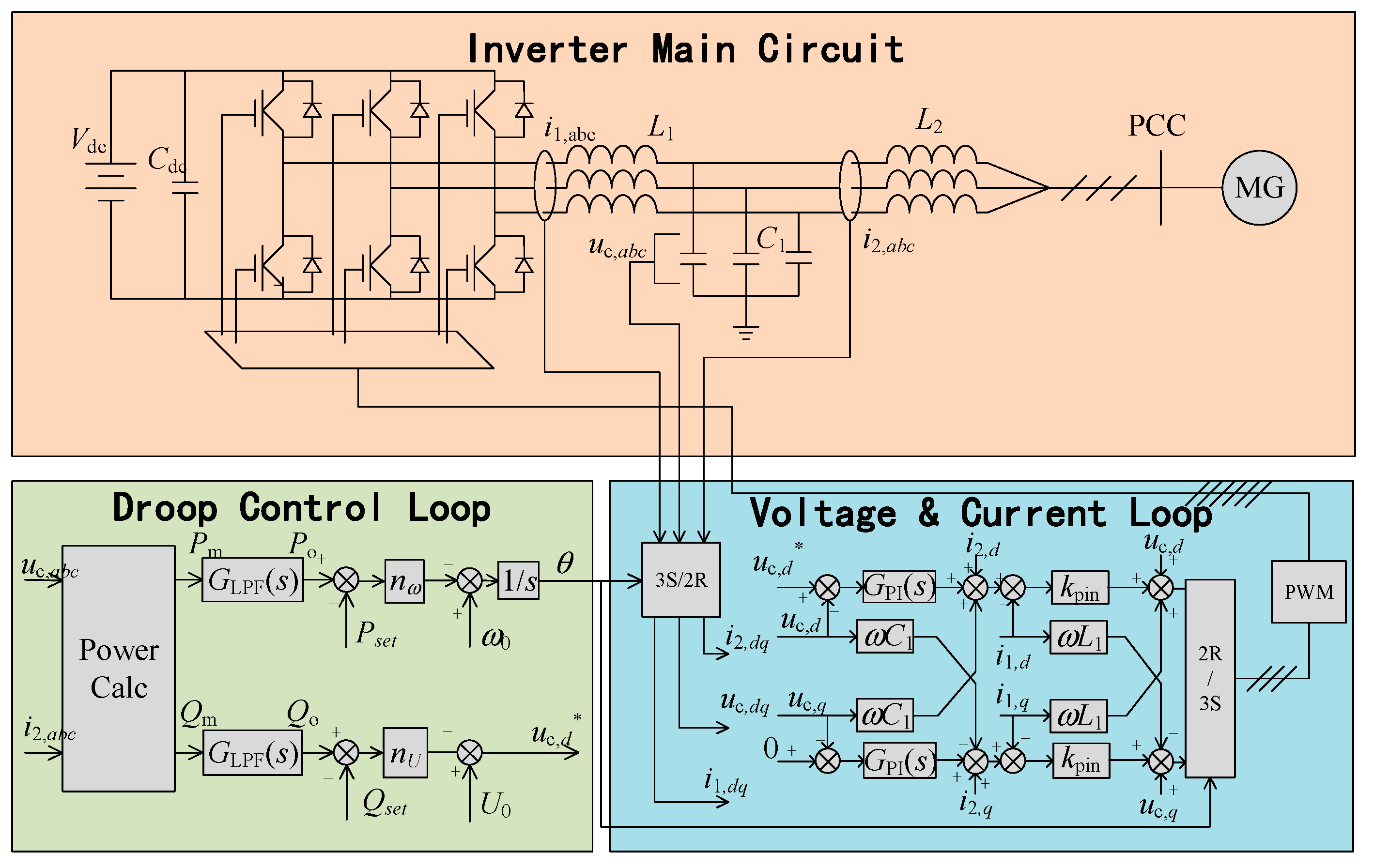
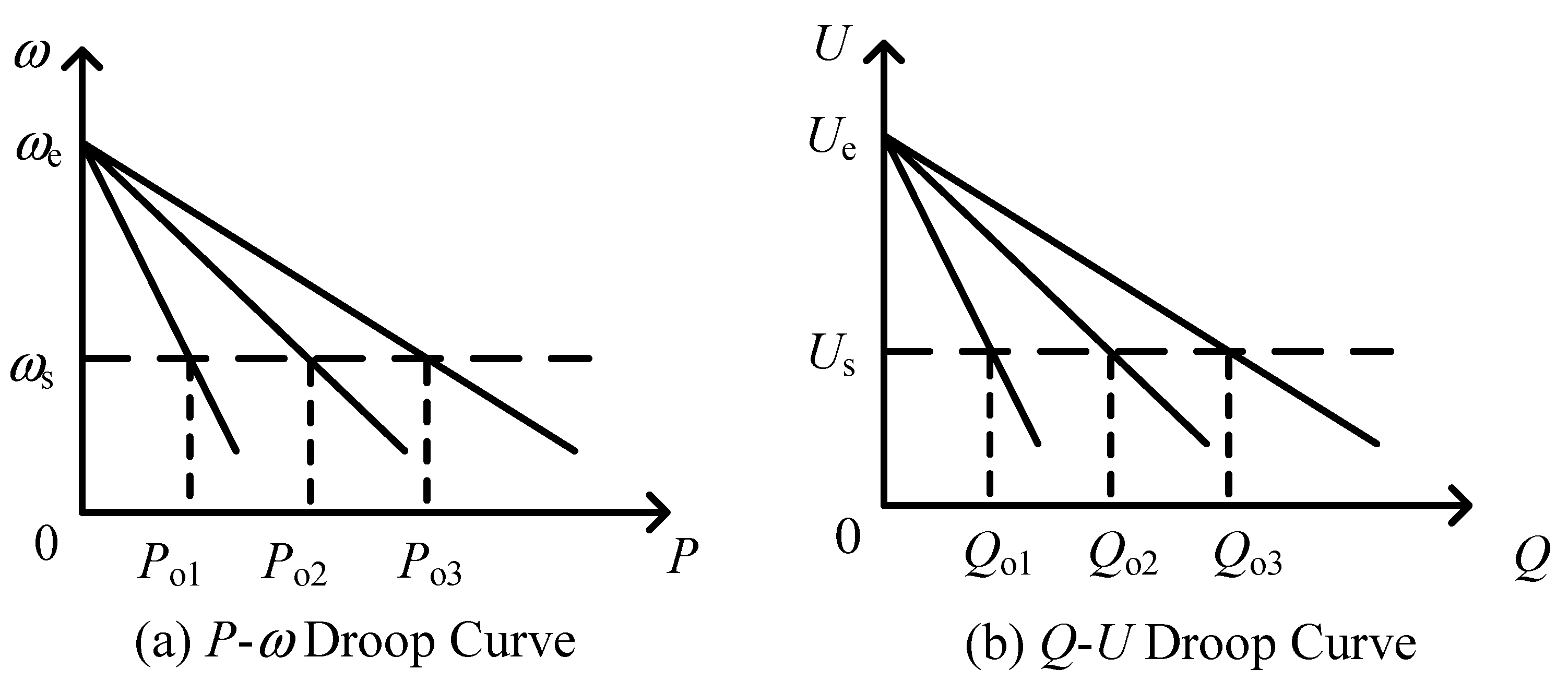
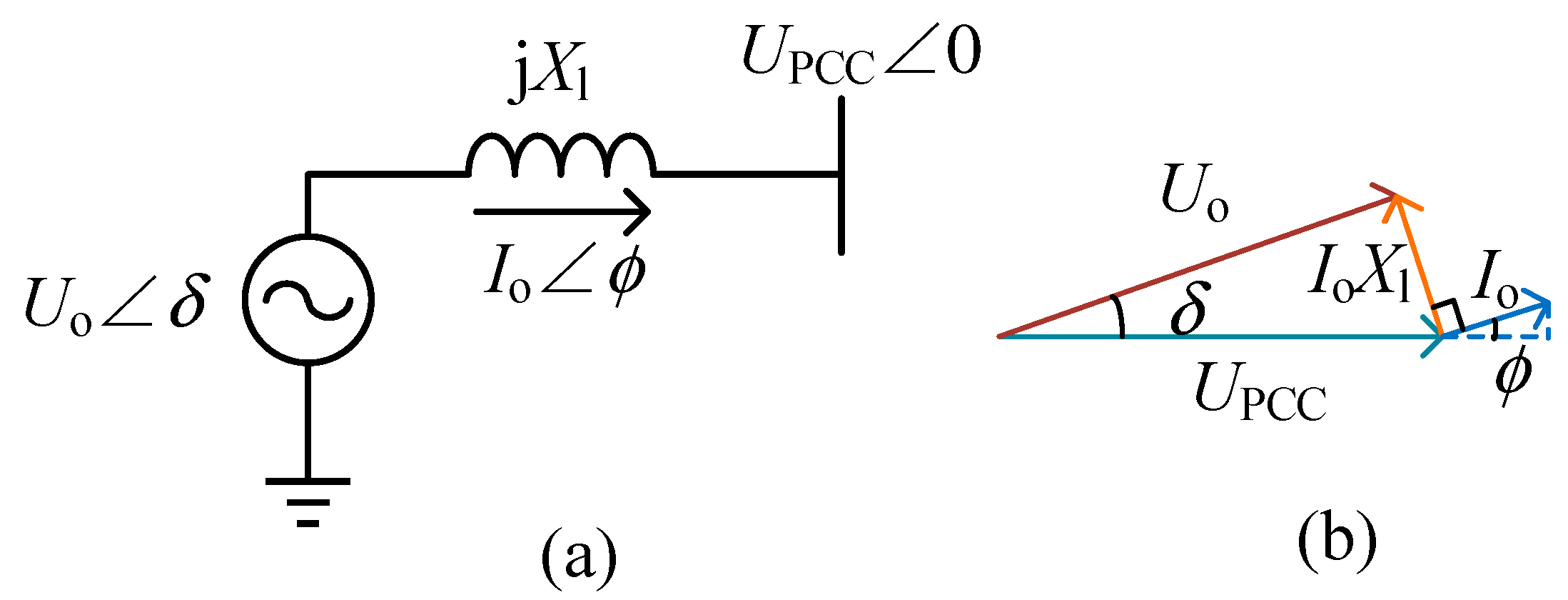
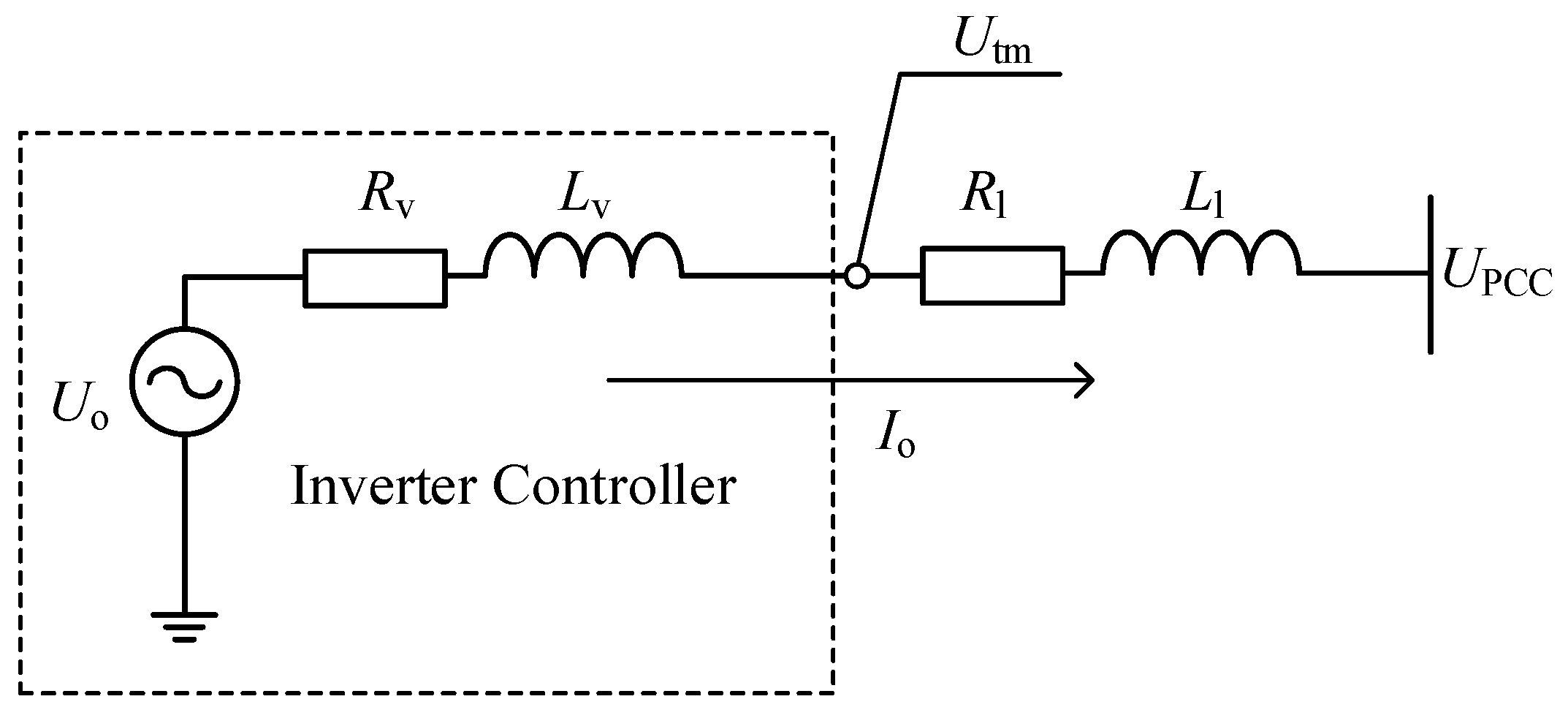
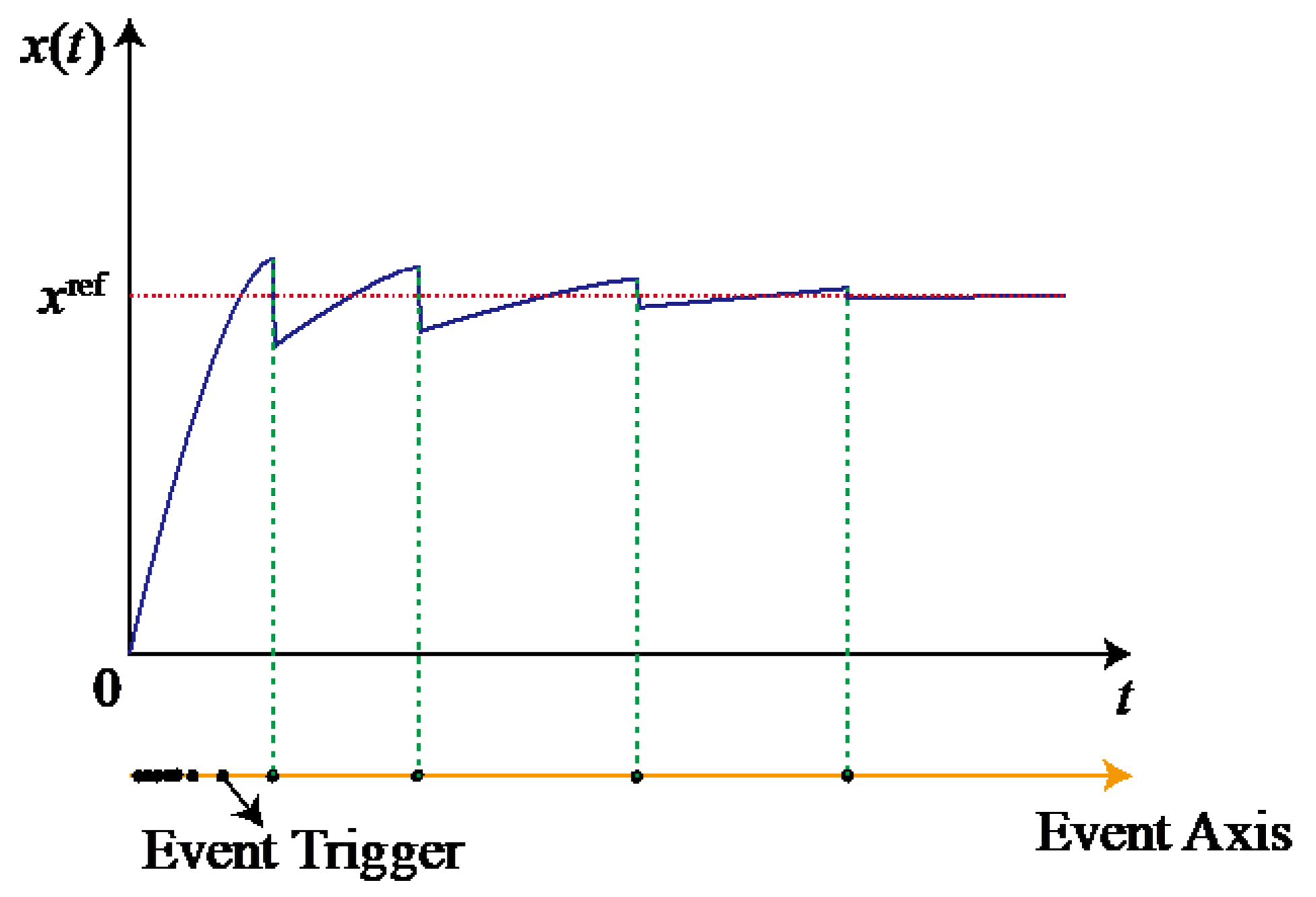

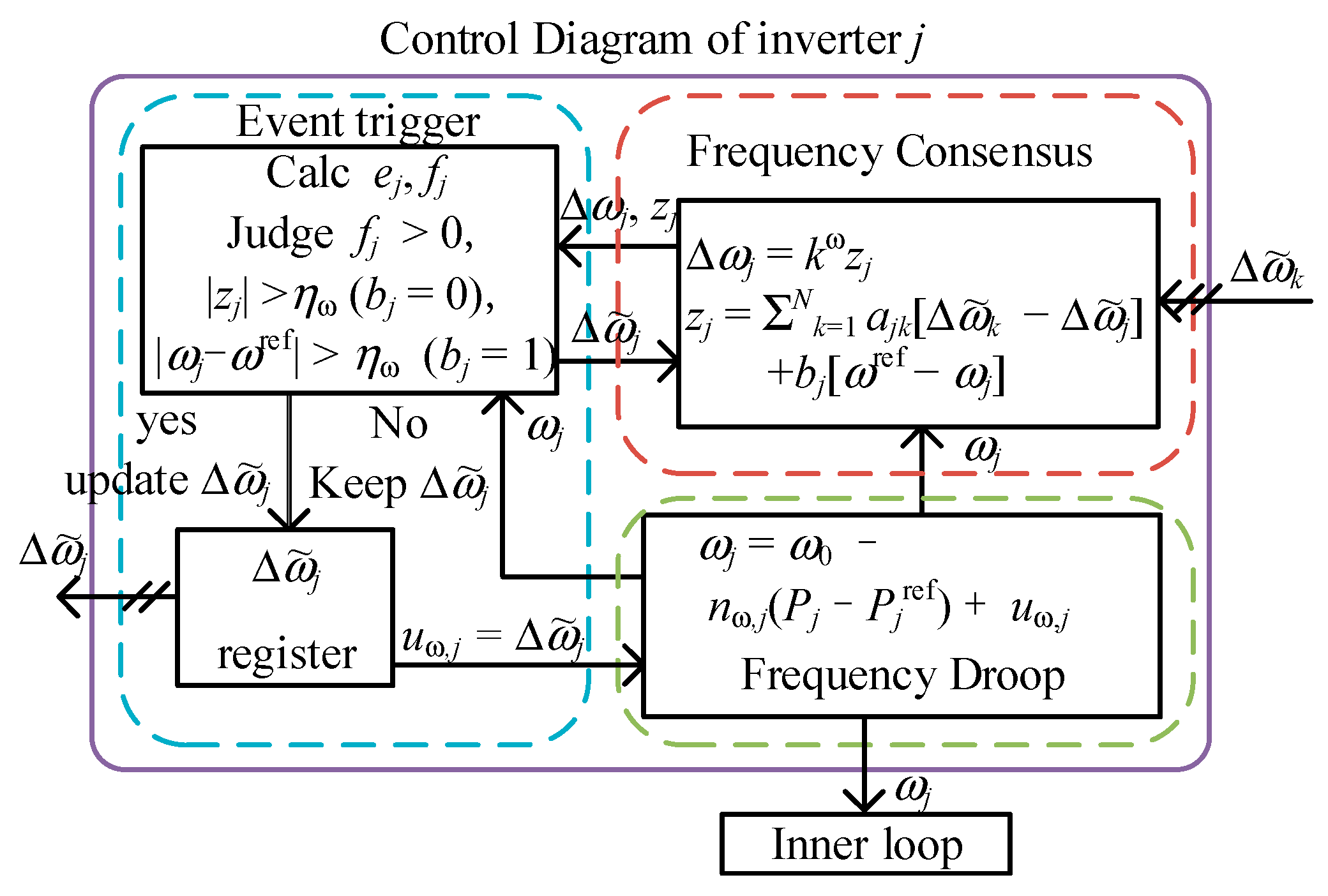
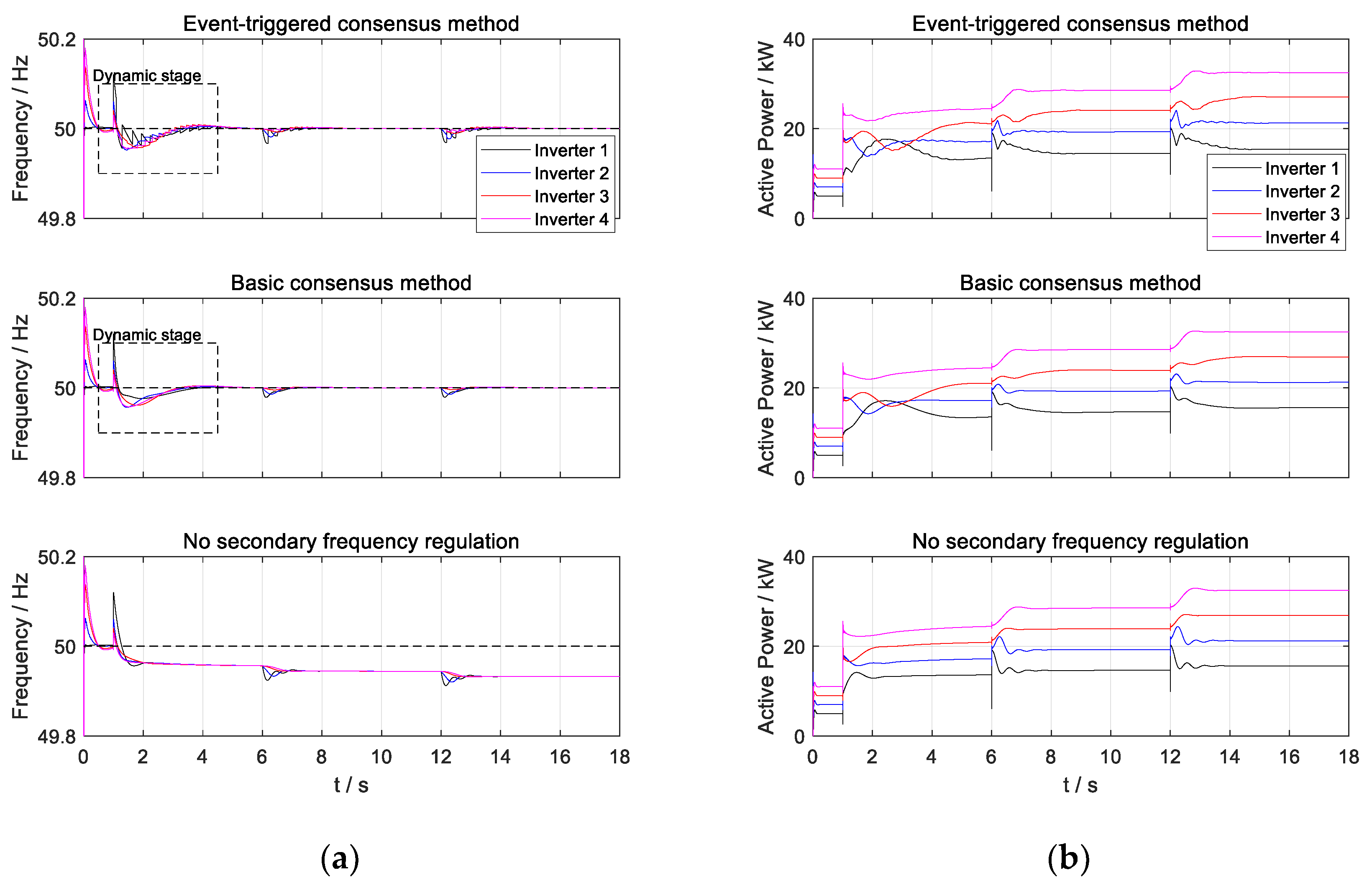

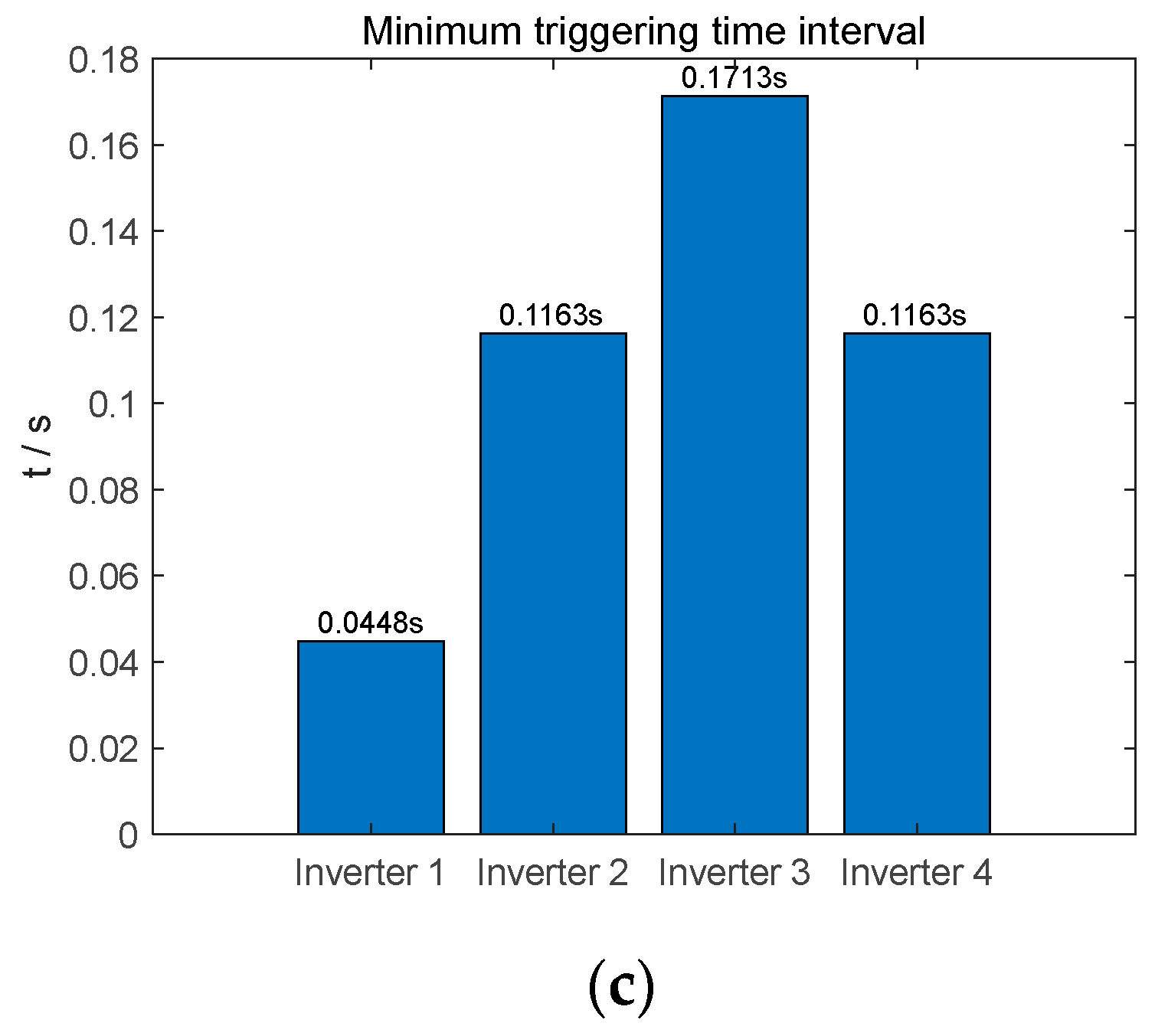
| Research Category | Literature | Abstract | Cost | Complexity | Accuracy |
|---|---|---|---|---|---|
| Centralized | [30] | Optimal model established and OPF function solving method proposed. | High | High | High |
| [31] | Realizes the secondary-frequency regulation task by introducing a common frequency reference system. | High | Low | Medium | |
| [32] | Sliding-mode control-based centralized voltage and frequency secondary-regulation method is proposed. | Medium | Medium | Low | |
| [33] | Separates the inverters as microgrid clusters and increases the output voltage quality. | Low | High | Low | |
| [34] | Proposes an MPC-based centralized microgrid control method. Also considers the constraints of frequency variation and SOC of the energy storage device. | High | High | High | |
| Decentralized | [35] | An LQR-based method is proposed for local frequency and voltage regulation. Large local calculation. | High | High | Medium |
| [36] | MPC-based decentralized frequency regulation method. | High | High | Medium | |
| [37] | Frequency regulation method without communication. Needs additional stabilizer part. | Low | Medium | Low | |
| Distributed | [39] | Time-delay impact analysis in consensus method. | \ | \ | \ |
| [40] | Small-signal model for consensus algorithm-based microgrid. | \ | \ | \ | |
| [41] | Hierarchical control structure with consensus algorithm-based frequency and voltage regulation. | High | High | High | |
| [42] | Event-triggered-based consensus method for secondary-frequency regulation. | Low | High | High |
| Research Category | Literature | Abstract | Cost | Complexity | Effects |
|---|---|---|---|---|---|
| Method Proposed | [37,72] | Adaptive virtual impedance method for reactive power sharing based on transient virtual impedance. | Medium | Low | Power sharing |
| [74] | Particle swarm optimization based on virtual impedance design for oscillation damping. | High | Medium | Stability | |
| [77] | Virtual impedance method with dq current droop and additional compensator. | Medium | Low | Power sharing and stability | |
| [81] | Proposes a distributed adaptive virtual impedance method for stability enhancement. CAN bus communication is implemented. | High | High | Stability | |
| [83] | Successive approximation-based virtual impedance method. The value of Lv and Rv is time dynamic. | Medium | Low | Stability | |
| [85] | Adaptive virtual impedance method using consensus algorithm. | High | High | Power sharing | |
| [88] | DQ frame asymmetrical virtual impedance method. | Medium | Medium | Harmonic wave sharing | |
| [89] | Online optimization of virtual impedance scheme. | High | Medium | Power sharing | |
| Novel Application | [71] | Uses source-side virtual impedance method for cascaded system stability enhancement. | Medium | High | Stability |
| [75] | Uses virtual impedance method for capacitive coupling inverters. | Low | Low | Stability on special situation | |
| [76] | Uses virtual impedance for active and reactive power decoupling. | Medium | High | Power sharing | |
| [84] | Multi-frequency band virtual impedance for better current quality. | High | High | Harmonic wave sharing | |
| [86] | Virtual impedance method for accurate harmonic power sharing. | High | High | Harmonic power sharing | |
| Analysis | [70] | Virtual impedance technique stability and function of circling current suppression. | \ | \ | \ |
| [73,82] | Parameter design and analysis of virtual impedance method for week grids. | \ | \ | \ | |
| [78] | Critical clearing time analysis for inverter-based power system under the impact of virtual impedance. | \ | \ | \ | |
| [79,87] | Virtual impedance method and the harmonic stability and unbalanced operation condition analysis. | \ | \ | \ | |
| [80] | Rate of change of frequency analysis for inverters with virtual impedance control scheme. | \ | \ | \ |
| Subject | Parameter | Value |
|---|---|---|
| Network | Lg1/mH, Rg1/Ω | 0.35, 0.03 |
| Lg2/mH, Rg2/Ω | 0.35, 0.03 | |
| Lg3/mH, Rg3/Ω | 0.35, 0.03 | |
| Lg4/mH, Rg4/Ω | 0.35, 0.03 | |
| Ll1/mH, R11/Ω | 0.318, 0.23 | |
| Ll2/mH, Rl2/Ω | 1.847, 0.35 | |
| Ll3/mH, Rl3/Ω | 0.318, 0.23 | |
| Ll4/mH, Rl4/Ω | 0.194, 0.02 | |
| Load | (PL1 + jQL1)/V·A | (45.9 + j22.8) × 103 |
| (PL2 + jQL2)/V·A | (36 + j36) × 103 | |
| (PL3 + jQL3)/V·A | (9.07 + j0) × 103 | |
| (PL4 + jQL4)/V·A | (9.07 + j0) × 103 | |
| Droop coefficient | nω,1/[(rad/s)/W] | 12 × 10−6 |
| nω,2/[(rad/s)/W] | 6 × 10−6 | |
| nω,3/[(rad/s)/W] | 4 × 10−6 | |
| nω,4/[(rad/s)/W] | 3 × 10−6 |
| Parameter | Value |
|---|---|
| LCL inverter side inductorL1/mH | 3 |
| LCL inverter side ESR/Ω | 0.3 |
| LCL grid side inductor/mH | 1.8 |
| LCL grid side ESR/Ω | 0.18 |
| LCL capacitor/μF (Y-Connection) | 4.7 |
| Three phase rate line voltage/V | 380 |
| System frequency/Hz | 50 |
| PWM frequency/kHz | 10 |
| Proportional gain of current loop | 10 |
| Proportional gain for voltage loop | 0.11 |
| Integral gain for voltage loop | 50 |
| Active reference for droop loop/kW | 10 |
| Reactive reference for droop loop/kVar | 0 |
| Time constant of power filter/s | 0.1592 |
| Parameter | Value | |
|---|---|---|
| Consensus gain kω | 1.0 | |
| Judgment coefficient | σ1 | 0.5 |
| σ2 | 0.5 | |
| σ3 | 0.5 | |
| σ4 | 0.5 | |
| Gate value for anti-chattering η | 0.002 | |
| Event detection cycle/ms | 0.1 | |
Publisher’s Note: MDPI stays neutral with regard to jurisdictional claims in published maps and institutional affiliations. |
© 2022 by the authors. Licensee MDPI, Basel, Switzerland. This article is an open access article distributed under the terms and conditions of the Creative Commons Attribution (CC BY) license (https://creativecommons.org/licenses/by/4.0/).
Share and Cite
Dong, J.; Gong, C.; Bao, J.; Zhu, L.; Hou, Y.; Wang, Z. Secondary-Frequency and Voltage-Regulation Control of Multi-Parallel Inverter Microgrid System. Energies 2022, 15, 8533. https://doi.org/10.3390/en15228533
Dong J, Gong C, Bao J, Zhu L, Hou Y, Wang Z. Secondary-Frequency and Voltage-Regulation Control of Multi-Parallel Inverter Microgrid System. Energies. 2022; 15(22):8533. https://doi.org/10.3390/en15228533
Chicago/Turabian StyleDong, Jiawei, Chunyang Gong, Jun Bao, Lihua Zhu, Yuanjun Hou, and Zhixin Wang. 2022. "Secondary-Frequency and Voltage-Regulation Control of Multi-Parallel Inverter Microgrid System" Energies 15, no. 22: 8533. https://doi.org/10.3390/en15228533
APA StyleDong, J., Gong, C., Bao, J., Zhu, L., Hou, Y., & Wang, Z. (2022). Secondary-Frequency and Voltage-Regulation Control of Multi-Parallel Inverter Microgrid System. Energies, 15(22), 8533. https://doi.org/10.3390/en15228533






